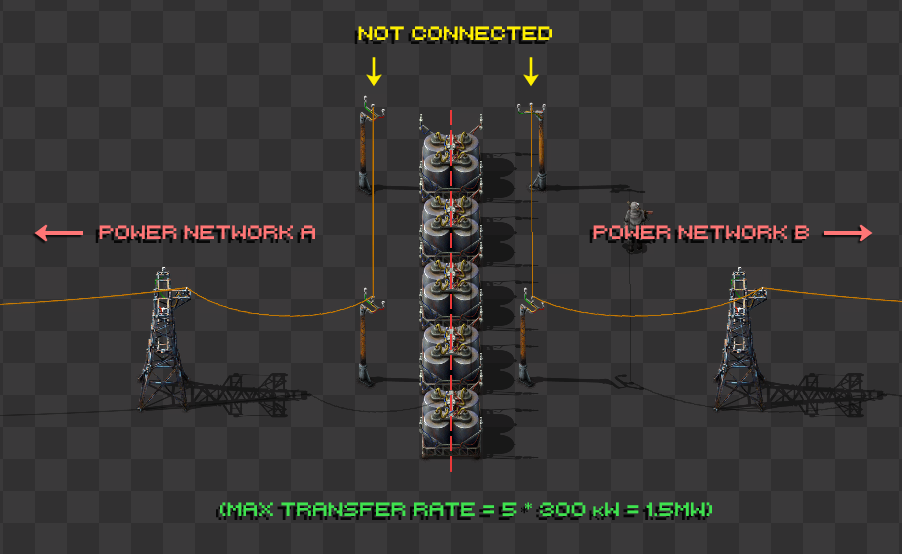Power production
< Power production | Special accumulator usages
Isolation of Power Networks
Accumulators can be used to isolate two separate power networks, which has a number of uses. Since accumulators have a lower delivery priority than any other entity, this guarantees that they only receive energy when you have enough left over after powering all other entities in a network. At the same time, accumulators can also be used to deliver energy in another electrical network, and can charge and discharge at the same time. Consider the following example:
The two power networks A and B are not directly connected to each other: They are connected only through the accumulators, which are shared by both networks. This is accomplished by setting up electric poles for each network connected to the accumulators, then ensuring the sets of poles are not connected to each other (which can be done by crafting a copper wire then dragging it between two connected poles to sever the connection, exactly as is done for disconnecting circuit wires).
In the above example:
- The accumulators will only charge if extra power is being produced by network A or B.
- The accumulators will discharge as needed into either network if one is not producing enough power.
- Since the maximum input/output rate of an accumulator is 300kW, power flow between the two networks will be limited to 300kW times the number of accumulators (1.5MW in the example).
- Note that this isolation is bidirectional: Either network can charge the accumulators, and the accumulators can discharge into either network.
This technique can be used whenever this type of isolation is desired.
Reduce Energy Consumption in Critical Situations
In particular, one good use for the above technique is to limit electricity consumption in low power situations by isolating non-critical parts of your factory (such as Radar, Labs, Electric furnaces, electric miners, Beacons, etc.) from critical parts (such as lasers, ammo production, or whatever your priorities are).
To do this, place your main generators and critical components on one network and place your non-critical components on another network, isolating the two as above. Now, two things will happen:
- Power will only flow to the non-critical network when you are generating a surplus on the main network, and
- The rate will always be limited to 300kW per accumulator.
Because the accumulators will only receive power if you have a surplus on the main network, this will in effect deactivate the low-priority network when electricity is in short supply. This will also limit power consumption by the low priority network if its usage becomes high, for example if you have two factories on a low priority network and usually only one of them runs at a time, if both happen to run they won't consume more than the total limit, they'll just slow down.
Essentially you are saying "only deliver power to these systems if I have enough to spare, and even then don't exceed this delivery rate".
In general this is a technique which works well when you've just researched accumulators and solar panels, but don't have enough resources to build big solar farms and accumulator farms yet.
Minimizing need for Steam power
Order of with accu connected networks
- Powering sequence - the order in which accumulators are loaded. This is also about how the electric network orders internally new networks.
